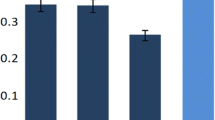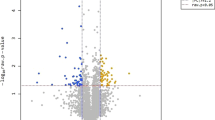Abstract
Genetic adaptation is one of the key features of Escherichia coli (E. coli) that ensure its survival in different hostile environments. E. coli seems to initiate biofilm development in response to specific environmental cues. A number of properties inherent within bacterial biofilms indicate that their gene expression is different from that of planktonic bacteria. Two of the possible important genes are rpoS and bolA. The rpoS gene has been known as the alternative sigma (σ) factor, which controls the expression of a large number of genes, which are involved in responses to a varied number of stresses, as well as transition to stationary phase from exponential form of growth. Morphogene bolA response to stress environment leads to round morphology of E. coli cells, but little is known about its involvement in biofilms and its development or maintenance. The purpose of this study was to understand and analyse the responses of rpoS and bolA gene to sudden change in the environment. In this study, E. coli K-12 MG1655, rpoS, and bolA mutant strains were used and gene expression was studied. Results show that both genes contribute to the ability to respond and adapt in response to various types of stresses. RpoS response to various stress environments was somehow constant in both the planktonic and biofilm phases, whereas bolA responded well under various stress conditions, in both planktonic and biofilm mode, up to 5–6-fold change in the expression was noticed in the case of pH variation and hydrogen peroxide stress (H2O2) as compared with rpoS.







Similar content being viewed by others
References
Adnan M, Morton G, Singh J, Hadi S (2010) Contribution of rpoS and bolA genes in biofilm formation in Escherichia coli K-12 MG1655. Mol Cell Biochem 342:207–213
Latasa C, Solano C, Penades JR, Lasa I (2006) Biofilm-associated proteins. C R Biol 329:849–857
Sauer K (2003) The genomics and proteomics of biofilm formation. Genome Biol 4:219
Harvey J, Keenan KP, Gilmour A (2007) Assessing biofilm formation by Listeria monocytogenes strains. Food Microbiol 24:380–392
Costerton JW, Stewart PS, Greenberg EP (1999) Bacterial biofilms: a common cause of persistent infections. Science 284:1318–1322
Mah TF, O’Toole GA (2001) Mechanisms of biofilm resistance to antimicrobial agents. Trends Microbiol 9:34–39
Beloin C, Michaelis K, Lindner K, Landini P, Hacker J, Ghigo J, Dobrindt U (2006) The transcriptional antiterminator RfaH represses biofilm formation in Escherichia coli. J Bacteriol 188:1316–1331
Richmond CS, Glasner JD, Mau R, Jin H, Blattner FR, Blattner FR, Bult CJ, Cole ST, Fleischmann RD, Himmelreich R, Kunst F, Chuang SE, Shalon D, Schena M, Welford SM, Khan J, DeRisi JL, Chu S, Zhu H, Wodicka L, Holstege FC, Spellman PT, Gingeras TR, Behr MA, Iyer VR, Eisen MB, Neidhardt FC, Sambrook J, Andre P, Lundberg KS, Cline J, Barnes WM, Webster C, Miller JH, Stokes HW, Wilbur WJ, Heller RA, Gross CA, Lindquist S, Lemaux PG, Yamamori T, Herendeen SL, Grossman AD, Erickson JW, Wang QP, Watson N, Yamanaka K, Missiakas D, De Las Penas A, Katayama Y, Gottesman S, Kroh HE, Conlin CA, Jiang X, Tsui HC, Herman C, Hall BG, Gold L, Henry MD, Riley M (1999) Genome-wide expression profiling in Escherichia coli K-12. Nucleic Acids Res 27:3821–3835
Santos JM, Freire P, Vicente M, Arraiano C, lia M (1999) The stationary-phase morphogene bolA from Escherichia coli is induced by stress during early stages of growth. Mol Microbiol 32:789–798
Dong T, Schellhorn H (2009) Control of RpoS in global gene expression of Escherichia coli in minimal media. Mol Gen Genomics 281:19–33
Vorob’eva LI (2004) Stressors, stress reactions, and survival of bacteria: a review. Appl Biochem Microbiol 40:217–224
Rowe MT, Kirk R (1999) An investigation into the phenomenon of cross-protection in Escherichia coli O157:H7. Food Microbiol 16:157–164
Hoch JA (2000) Two-component and phosphorelay signal transduction. Curr Opin Microbiol 3:165–170
Rhodius V, Van DTK, Gross C, LaRossa RA (2002) Impact of genomic technologies on studies of bacterial gene expression. Annu Rev Microbiol 56:599–624
Conway T, Schoolnik KG (2003) Microarray expression profiling: capturing a genome-wide portrait of the transcriptome. Mol Microbiol 47:879–889
Eriksson S, Lucchini S, Thompson A, Rhen M, Hinton JCD (2003) Unravelling the biology of macrophage infection by gene expression profiling of intracellular Salmonella enterica. Mol Microbiol 47:103–118
Chen C, Ridzon DA, Broomer AJ, Zhou Z, Lee DH, Nguyen JT, Barbisin M, Xu NL, Mahuvakar VR, Andersen MR, Lao KQ, Livak KJ, Guegler KJ (2005) Real-time quantification of microRNAs by stem-loop RT-PCR. Nucleic Acids Res 33:e179
Hengge-Aronis R, Fischer D (1992) Identification and molecular analysis of glgS, a novel growth-phase-regulated and rpoS-dependent gene involved in glycogen synthesis in Escherichia coli. Mol Microbiol 6:1877–1886
Hu N, Qian L, Hu Y, Shou ZJ, Wang C, Giffen C, Wang HQ, Wang Y, Glodstein MA, Buck EM, Taylor RP (2006) Quantitative real-time RT-PCR validation of differential mRNA expression of SPARC, FADD, Fascin, COL7A1, CK4, TGM3, ECM1, PPL and EVPL in esophageal squamous cell carcinoma. BMC Cancer 6:33
Dong T, Schellhorn H (2009) Global effect of RpoS on gene expression in pathogenic Escherichia coli O157:H7 strain EDL933. BMC Genomics 10:349
Vieira HLA, Freire P, Arraiano CM (2004) Effect of Escherichia coli morphogene bolA on biofilms. Appl Environ Microbiol 70:5682–5684
Corona-Izquierdo FP, Membrillo-Hernandez J (2002) A mutation in rpoS enhances biofilm formation in Escherichia coli during exponential phase of growth. FEMS Microbiol Lett 211:105–110
Adams JL, McLean RJC (1999) Impact of rpoS deletion on Escherichia coli biofilms. Appl Environ Microbiol 65:4285–4287
Acknowledgments
We gratefully acknowledge the supports from the National Bio Resource Project (NIG, Japan): E. coli for providing bacterial strains for use during this project and the Society for Applied Microbiology (sfam) for a research grant to complete this project.
Author information
Authors and Affiliations
Corresponding author
Rights and permissions
About this article
Cite this article
Adnan, M., Morton, G. & Hadi, S. Analysis of rpoS and bolA gene expression under various stress-induced environments in planktonic and biofilm phase using 2−ΔΔCT method. Mol Cell Biochem 357, 275–282 (2011). https://doi.org/10.1007/s11010-011-0898-y
Received:
Accepted:
Published:
Issue Date:
DOI: https://doi.org/10.1007/s11010-011-0898-y




